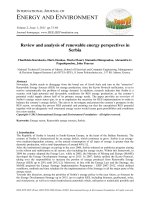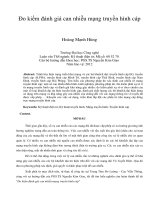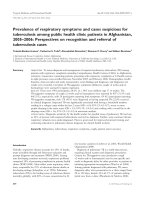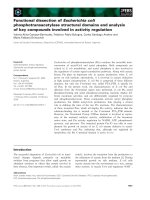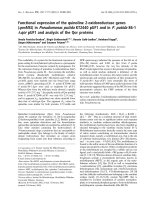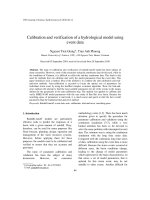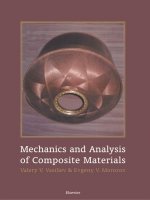Camera self calibration and analysis of singular cases
Bạn đang xem bản rút gọn của tài liệu. Xem và tải ngay bản đầy đủ của tài liệu tại đây (999.53 KB, 107 trang )
CAMERA SELF-CALIBRATION AND ANALYSIS OF
SINGULAR CASES
CHENG ZHAO LIN
(B.Eng.)
A THESIS SUBMITTED
FOR THE DEGREE OF MASTER OF ENGINEERING
DEPARTMENT OF MECHANICAL ENGINEERING
NATIONAL UNIVERSITY OF SINGAPORE
2003
i
Acknowledgements
The work described in this thesis is a cooperation project with The French National
Institute for Research in Computer Science and Control (INRIA). First, I am very
grateful to my supervisors Professor Poo Aun Neow and Professor Peter C.Y. Chen
for their consistent encouragement and advice during my two-year study in National
University of Singapore. More thanks also go to Prof. Chen who read the whole thesis
and gave many suggestions to revise it. Without their kind support, the work and the
thesis would not be completed.
I would like to express my deep gratitude to Dr. Peter Sturm, who kindly arranged
my visit to INRIA and enabled the cooperation. With the aid of emails, we exchanged
a lot of creative ideas, which immensely filled stuffs in my work. His strict attitude to
research also made me never be relaxed with some minor success. Without his help,
my work would not be published.
Here, I am also appreciated for a lot of useful discussion with a lot of people in
Control and Mechatronics Lab such as Duan Kai Bo, Ankur Dahnik, Tay Wee Beng,
Zhang Zheng Hua and Sun Jie. They never conserved in their advice.
Last but not least, I thank my dear parents and Li Min for their constant encouragement, understanding and support. These helped me get through many harsh days.
ii
Table of Contents
Summary..................................................................................vi
List of Tables ......................................................................... vii
List of Figures....................................................................... viii
Chapter 1. Introduction.............................................................1
1.1 Motivation ...................................................................................... 1
1.2 From 2D images to 3D model........................................................ 2
1.2.1 Image feature extraction and matching ..................................................... 2
1.2.2 Structure from motion ............................................................................... 3
1.2.3 Self-calibration.......................................................................................... 4
1.2.4 Dense 3D model........................................................................................ 5
1.3 Main contribution........................................................................... 5
1.4 Thesis outline ................................................................................. 6
Chapter 2. Projective Geometry ...............................................8
2.1 Introduction .................................................................................... 8
2.2 Duality............................................................................................ 9
2.3 Projective 2D and 3D geometry................................................... 10
2.3.1 The 2D projective plane .......................................................................... 10
2.3.2 The 3D projective space.......................................................................... 10
2.3.3 The plane at infinity ................................................................................ 11
iii
2.3.4 Conics and quadrics ................................................................................ 12
2.4 Conclusion.................................................................................... 13
Chapter 3. Two-View Geometry ............................................14
3.1 Camera model .............................................................................. 14
3.1.1 Perspective projection camera model...................................................... 14
3.1.2 Intrinsic parameters................................................................................. 16
3.1.3 Extrinsic parameters................................................................................ 16
3.1.4 Radial distortion ...................................................................................... 17
3.2 Epipolar geometry and the fundamental matrix .......................... 18
3.2.1 Epipolar geometry................................................................................... 18
3.2.2 The fundamental matrix .......................................................................... 19
3.3 Recovery of camera matrix from the fundamental matrix........... 21
3.3.1 Canonical form of camera matrices of a stereo rig ................................. 21
3.3.2 Camera matrices obtained from F........................................................... 22
3.4 The fundamental matrix computation.......................................... 22
3.4.1 Linear approaches for F computation ................................................... 23
3.4.2 Nonlinear approaches for F computation.............................................. 25
3.4.3 Robust estimation of the fundamental matrix ......................................... 26
3.5 The stratification of the 3D geometry.......................................... 29
3.5.1 The 3D projective structure..................................................................... 29
3.5.2 The 3D affine structure ........................................................................... 29
3.5.3 The 3D metric structure .......................................................................... 30
3.5.4 Camera self-calibration, the bond between projective reconstruction and
metric reconstruction ............................................................................................ 32
iv
Chapter 4. Camera self-calibration .........................................34
4.1 Kruppa's equations based camera self-calibration ....................... 34
4.1.1 Absolute conic and image of the absolute conic..................................... 34
4.1.2 Kruppa's equations .................................................................................. 37
4.1.3 Simplified Kruppa's equations ................................................................ 39
4.2 Review of Camera self-calibration .............................................. 41
4.2.1 Self-calibration for stationary cameras ................................................... 41
4.2.2 Kruppa's equations based self-calibration for two special motions ........ 42
4.2.3 Self-calibration from special objects....................................................... 43
4.3 Focal length self-calibration from two images ............................ 45
Chapter 5 Singular cases analyses ..........................................47
5.1 Critical motion sequences for camera self-calibration ................ 48
5.1.1 Potential absolute conics ......................................................................... 49
5.1.2 PAC on the plane at infinity.................................................................... 49
5.1.3 PAC not on the plane at infinity.............................................................. 50
5.1.4 Useful critical motion sequences in practice........................................... 51
5.2 Singular cases for the calibration algorithm in Section 4.3 ......... 52
5.2.1 Generic singularities ............................................................................... 52
5.2.2 Heuristic interpretation of generic singularities...................................... 53
5.2.3 Algebraic interpretation of generic singularities..................................... 55
5.2.4 Conclusion .............................................................................................. 58
Chapter 6 Experiment results..................................................60
6.1 Experiment involving synthetic object ........................................ 60
v
6.1.1 Synthetic object and images.................................................................... 60
6.1.2 Performance with respect to Gaussian noise level.................................. 61
6.1.3 Detecting different singular cases for the linear and quadratic equations62
6.2 Experiment involving actual images............................................ 65
6.2.1 Camera setup........................................................................................... 66
6.2.2 Experiment involving images taken from a special object ..................... 66
6.2.3 Calibration using arbitrary scenes........................................................... 74
6.3 Conclusion.................................................................................... 78
Chapter 7 Conclusion .............................................................80
Reference ................................................................................81
Appendix A ............................................................................87
Orthogonal least squares problem...................................................... 87
Appendix B.............................................................................88
B.1 The equivalent form of the semi-calibrated fundamental matrix 88
B.2 Coplanar optical axes .................................................................. 89
B.3 Non-coplanar optical axes ........................................................... 92
B.3.1 Linear equations ..................................................................................... 92
B.3.2 Quadratic equation.................................................................................. 94
vi
Summary
Obtaining a 3D model for the world is one of the main goals of computer vision.
The task to achieve this goal is usually divided into several modules, i.e., projective
reconstruction, affine reconstruction, metric reconstruction, and Euclidean reconstruction. Camera self-calibration, which is one key step among them, links the so-called
projective and metric reconstruction. However, a lot of existed self-calibration algorithms are fairly unstable and thus fail to take up this role. The main reason is that singular cases are not rigorously detected.
In this thesis, a new camera self-calibration approach based on Kruppa's equations
is proposed. We assume only the focal length is unknown and constant, the Kruppa's
equations are then decomposed as two linear and one quadratic equations. All of generic singular cases, which are nearly correspondent to algebraically singular cases for
those equations are fully derived and analyzed. We then thoroughly carry out experiments and find that the algorithm is quite stable and easy to implement when the generic singular cases are excluded.
vii
List of Tables
Table 6.1: Calibration results with respect to the principal point estimation ............... 68
Table 6.2: Experiment considering the stability of this algorithm................................ 70
Table 6.3: Reconstruction results using calibrated focal length ................................... 74
Table 6.4: Results calibrated from images containing 3 cups ...................................... 75
Table 6.5: Results calibrated from images containing a building................................. 76
viii
List of Figures
Figure 2.1: Line-point dual figure in projective 2D geometry........................................ 9
Figure 3.1: The pinhole camera model ......................................................................... 15
Figure 3.2: The Euclidean transformation between the world coordinate system and
the camera coordinate system ............................................................................... 17
Figure 3.3: Epipolar geometry ...................................................................................... 19
Figure 3.4: Different structures recovered on different layers of 3D geometry ........... 31
Figure 4.1: Absolute conic and its image...................................................................... 37
Figure 5.1: Illustration of critical motion sequences. (a) Orbital motion. (b) Rotation
about parallel axes and arbitrary translation. (c) Planar motion (d) Pure rotations
(not critical for self-calibration but for the scene reconstruction). ....................... 52
Figure 5.2: Possible camera center positions when the PAC is not on Π ∞ . (a) The
PAC is a proper virtual circle. All the camera centers are on the line L. (b) The
PAC is a proper virtual ellipse. All the camera centers are on a pair of
ellipse/hyperbola. .................................................................................................. 54
Figure 5.3: Illustration of the equidistant case (arrows show the directions of camera's
optical axes) .......................................................................................................... 55
Figure 5.4: Configuration of non-generic singularity for the linear equations ............. 58
Figure 6.1: The synthetic object.................................................................................... 61
Figure 6.2: Relative error of focal length with respect to Gaussian noise level ........... 62
Figure 6.3: Coordinates of two cameras ....................................................................... 63
Figure 6.4: Coplanar optical axes (neither parallel nor equidistance case) .................. 64
Figure 6.5: The two camera centers are near to be equidistant from the intersection of
the two optical axes............................................................................................... 65
Figure 6.6: The two optical axes are near parallel ........................................................ 65
Figure 6.7: Some images of the calibration grid........................................................... 67
Figure 6.8: Effect of the principal point estimation on the focal length calibration..... 69
Figure 6.9: The middle plane ........................................................................................ 70
Figure 6.10: Sensitivity of focal length with respect to the angle c.............................. 71
ix
Figure 6.11: Images of three cups................................................................................. 76
Figure 6.12: some images of a building........................................................................ 77
Figure 6.13: The reconstructed cup. First row: general appearance of the scene, once
with overlaid triangular mesh. Second row: rough top view of cups and two
close-ups of the plug in the background (rightmost image shows the near
coplanarity of the reconstruction). Third row: top views of two of the cups,
showing that their cylindrical shape has been recovered...................................... 78
x
Nomenclature
In order to enhance readability of the thesis, a few notations are used throughout
the thesis. Generally, 3D points are represented in capital form and their images are
the same letters of low case form. Vectors are column vectors embraced in square
brackets. Homogeneous coordinates differ with their correspondent inhomogeneous
dummies by adding a "~" on their heads.
×
cross product
.
dot product
AT
transpose of the matrix A
P
the projection matrix
∏
world plane (4-vector)
∏∞
the plane at infinity
l
image line (3-vector)
A
camera intrinsic parameter matrix
F
fundamental matrix
AC
absolute conic
IAC
image of the absolute conic
DIAC
dual of IAC
v
Euclidean norm of the vector v
~
equivalent up to scale
1
Chapter 1. Introduction
1.1 Motivation
Computer vision system attempts to mimic human being's vision. They first appear
in robotics applications. The commonly accepted computational theory of vision proposes that constructing a model of the world is a prerequisite for a robot to carry out
any visual task [22]. Based on such a theory, obtaining 3D model becomes one of the
major goals of the computer vision community.
Increased interests on application of computer vision come from entertainment and
media industry recently. One example is that a virtual object is generated and merged
into a real scene. Such application heavily depends on the availability of an accurate
3D model.
Conventionally, CAD or 3D modeling system is employed to obtain a 3D model.
The disadvantage of such approaches is that the costs in terms of labor and time investment often rise to a prohibitive level. Furthermore, it is also difficult to include
delicate details of a scene into a virtual object.
An alternative approach is to use images. Details of an object can be copied from
images to a generated virtual object. The remaining problem is that 3D information is
lost by projection. The task is then to recover the lost depth to a certain extent1.
The work reported in this thesis deals with this task of depth recovery in the reconstruction of 3D models using 2D information. Due to the limited time and space, it
does not cover all the details of how to obtain a 3D model. Instead, it focuses on the
1
Details on the different kind of reconstruction (or structure recovery) will be discussed in later
chapters.
2
so-called camera self-calibration that is a key step for constructing 3D models using
2D images.
1.2 From 2D images to 3D model
As we may see in the later chapters, camera self-calibration is one of important
steps in automatic 3D modeling. Therefore it is a logical start that we first introduce
how to reconstruct a 3D model.
Although it is natural for us to perceive 3D, it is hardly so for a computer. The fundamental problems associated with such a perception task are what can be directly obtained from images and what can help a computer to find 3D information from images.
Those problems are usually categorized as image feature extraction and matching.
1.2.1 Image feature extraction and matching
Most of us have the experience that if we look at a homogeneous object (such as a
white wall), there is no way to perceive 3D. We have to depend on some distinguished
features to do so. Such distinguished features may be corners, lines, curves, surfaces,
and even colors. Usually, corners or points are used since they can be easily formulated by mathematics. Harris corner detector [8] shows superior performance considering the criteria of independence of camera pose and illumination change [27]. Matching between two images is a difficult task in image processing since a little change of
conditions (such as illumination or camera pose) may produce very different matches.
Hence current cross-correlation approaches that are widely employed often assume
that images are not very different from each other.
3
1.2.2 Structure from motion
After some image correspondences (i.e. pairwise matches) are obtained, the next
step toward 3D model is to recover the scene's structure. The word "structure" we use
here does not have the same meaning as what we imagine in the Euclidean world. The
connotation of structure in the field of computer vision depends on the different layers
of 3D geometry. This stratification of 3D geometry will be discussed in detail in the
later chapters. We just give a brief introduction here. Generally, if no information other
than the image correspondences is available, a projective reconstruction can be done at
this stage. In fact, as we may see in Chapter 3, the structure is recovered up to a 4 × 4
arbitrary projective transformation matrix. However, when the camera's intrinsic parameter matrix is known, the structure could be recovered up to an arbitrary similarity
transformation. Such similarity transformation has one degree of freedom more than a
Euclidean transformation, which is determined by a rotation and a translation. That
one-degree of freedom is exactly the yardstick to measure the real object's dimension.
At this stage, this process of structure recovery is called the metric reconstruction.
Early work on structure from motion assumes that the camera intrinsic parameter
matrix is known. Based on this assumption, camera motion and the scene's structure
can be recovered from two images [19], [40] or from image sequences [30], [34]. A
further assumption of the affine camera model can give another robust algorithm [35].
Since the so-called fundamental matrix was obtained by Faugeras [5] and Hartley
[9], uncalibrated structure from motion has been drawing extensive attention from researchers. The fundamental matrix computation is the starting point to conduct such
research. Two papers [36, 43] represent the existing state-of-the-art research in this
area. After the fundamental matrix is obtained, the camera matrices can be constructed
with some extent of ambiguity. This will be discussed in detail in Chapter 3.
4
1.2.3 Self-calibration
Camera self-calibration is the crux that links the projective and metric reconstruction. Self-calibration means that the cameras can be calibrated just from images without any calibration pattern of known 3D information. It is very interesting since in the
last subsection, we note that only the projective reconstruction can be obtained from
images. However, the camera's intrinsic parameter matrix is exactly constrained by the
so-called images of the absolute conic (IAC), which in fact can be obtained from images through the so-called Kruppa's equations. We will present this in detail in Chapter
Four.
Faugeras and Maybank initiated the research on Kruppa's equations based camera
self-calibration [6]. Hartley then conducted a singular value decomposition (SVD)
based simplification of the Kruppa's equations [13]. These simplified Kruppas' equations clearly show that two images give rise to two independent equations that impose
constraints on the camera's intrinsic parameter matrix. Since the camera's intrinsic parameter matrix has 5 unknown parameters, at least three images are needed (One fundamental matrix introduces two independent Kruppa's equations. Three images lead to
three fundamental matrices and then six equations would be obtained if no degeneration occurs).
A lot of algorithms on camera self-calibration were proposed [45] [46] in the past
ten years. However, the calibrated results seemed not so satisfactory [47]. Recently, a
lot of researchers delved into the existing problems in camera self-calibration. Sturm
showed that some special image sequences could result in incorrect constraints on the
camera parameter matrix [31, 32]. The corresponding camera motions are then called
critical motion sequences [31]. The geometric configurations corresponding to critical
motion sequences are called the singular cases (or the singularities) of a calibration al-
5
gorithm in this thesis. In addition to the analyses of the critical motion sequence analyses, some researchers also found constraints on the camera's intrinsic parameters would
yield more robust results [24] [48]. We propose that if some camera's intrinsic parameters are known first, singularities of a calibration algorithm would be discovered as a
whole [49]. This part of work on singularities will be discussed in Chapter 5.
1.2.4 Dense 3D model
The structure recovered from the approaches discussed in the last subsection has
only restricted feature points. Those points are not sufficient for robot vision and object recognition. Hence a dense 3D model needs to be recovered. However, since after
structure recovery, the geometry among cameras has been found and then it is easy to
match other common points in the images. Typical matching algorithms at this stage
are area-based algorithms (such as [3, 15]) and space carving algorithms (such as [17]
[28]). Details can be found in the work by P. Torr [37]1.
1.3 Main contribution
Before we move on to present the technical details, it is essential to clarify the contribution made by the author.
1. Theoretically, our work stands on two footstones. Firstly, three calibration
equations are obtained (in Section 4.3, Chapter 4). One of them is quadratic and
the remaining is linear. Focal length is in the closed form in these equations,
and thus solution is easy to obtain. Secondly, all of singular cases associated
with the equations are described geometrically and derived algebraically (in
1
An alternative way is by optical flow. However, it estimates the camera geometry and dense matching simultaneously and thus we don't discuss it here.
6
Section 5.2, Chapter 5 and Appendix B). Part of the results has been published
in our paper [2].
2. Experimentally, intensive tests have been conducted both on simulated and real
data (in Chapter 6). This part of work together with the theoretical work is described in the report [49].
1.4 Thesis outline
This thesis consists of seven chapters. Chapter 2 introduces basic concepts of projective geometry that are needed in the later part of the thesis. Since a camera is a 3D
to 2D projection model, only the 2D projective plane and 3D projective space are presented in Chapter 2. The concept of duality, which is essential to the Kruppa's equations, is also introduced in this chapter. Some geometric entities such as points, lines,
planes, and conics are briefly discussed as well.
Two-view geometry, which is fundamental to the new self-calibration algorithm in
this thesis, is then introduced in Chapter 3. We start with the camera model, and twoview geometry (or epipolar geometry) is then established. The fundamental matrix
(which is the core of two-view geometry) is then fully presented. Next, the recovery of
camera matrix from the fundamental matrix is discussed. Here, we also discuss computation of the fundamental matrix. This section is essential since the fundamental matrix
computation determines the performance of the calibration algorithm presented in the
thesis. Finally, the stratification of the 3D geometry is presented. The role of camera
self-calibration gradually emerges after such stratification.
In Chapter 4, we focus on camera self-calibration. Kruppa's equations are first introduced through the invariant of the images of the absolute conic (IAC) with respect
to camera motions. A brief history of camera self-calibration is introduced, and a few
7
relevant important algorithms are reviewed. Our focal length calibration algorithm is
then presented after the introduction of Hartley's simplification of Kruppa's equations
[13].
Chapter 5 starts by discussing so-called critical motions that make camera selfcalibration impossible. After then, we give heuristic and algebraic analysis of singular
cases for our algorithm. Both of them nearly lead to the same results.
Both simulation and experiments with actual images are presented in Chapter 6. We
show that the proposed algorithm is very stable, and the results perfectly match the
analysis on singular cases of the chapter 5.
Conclusion is drawn in Chapter 7. To enhance the readability of this text, some of
mathematical derivations are placed in appendices.
8
Chapter 2. Projective Geometry
This chapter discusses some important concepts and properties of projective geometry. First, some basic concepts of n dimensional projective space are introduced in Section 2.1. Then in Section 2.2, the concept of duality is presented. Two important instances of projective geometry (namely the 2D projective plane and the 3D projective
space) are then discussed in Section 2.3. Some important geometric entities are also
presented in this section. Various background information discussed in this chapter can
be found in the books by Faugeras[7], Wolfgang Bohem and Hartmut Prautzsch[1],
and Semple and Kneebone[29].
2.1 Introduction
With the introduction of Cartesian coordinates in Euclidean geometry, geometry
became closely associated with algebra. Usually, a point in R n is given by an n-vector
of coordinates, i.e., X = [x1 ... x n ] . Homogeneous coordinates, which are footstone of
T
projective geometry, however, add one dimension up to an n+1-vector of coordinates,
~
T
x1 ... ~
x n +1 ] . Given homogeneous coordinates X , the Euclidean coordinates
i.e., X = [~
are obtained by
~
x
x1 = ~ 1 ,
x n +1
…,
~
x
xn = ~ n .
x n+1
(2.1.1)
Since the relationship (2.1.1) exists, two points X and Y in projective n-space are
equal if their homogeneous coordinates are related by xi = λy i , where λ is a nonzero
x n +1 = 0 , then the Euclidean coordinates go to infinity accordingly.
scalar. However, if ~
In projective geometry, such a point is called an ideal point or a point at the infinity.
The important role of such a point will be discussed in Section 2.3.2.
9
2.2 Duality
We note that the n dimensional projective space Ρ n can be expressed in n+1-vector
homogeneous coordinates. Therefore, a hyperplane in Ρ n , when expressed algebraically, is in the form of u t x = 0 . Here, u and x are both n+1-vectors and u is the hy-
perplane's coordinate vector. Then the coordinates of the hyperplane span another n
dimensional projective space Ρ ∗ that is called the dual space of Ρ n .
If the term "point" (in the previous paragraph, it is expressed in homogeneous coordinates x ) is interchanged with "hyperplane" and correspondently "collinear" with
"coincident" and "intersection" with "join", etc., then there is no way to tell the difference between the projective geometry formed by a space and by its dual space. Specifically, let us consider a line [1 2 3] in projective 2D geometry. Three points in hoT
mogeneous coordinates p1 = [− 1 − 1 − 1] , p 2 = [− 3 0 1] and p3 = [5 − 1 − 1] are on
T
T
T
this line. However, if we treat these three vectors as the lines' coordinate vectors, then
the lines finally intersect at a point [1 2 3] . Hence, points are interchanged with lines
T
(two dimensional hyperplane) and so are collinear and coincidence. The geometry after
the interchange is the same as the geometry before the interchange. Figure 2.1 shows
such dual relation.
Figure 2.1: Line-point dual figure in projective 2D geometry
10
2.3 Projective 2D and 3D geometry
Projective 2D and 3D geometry are the two most important projective geometries
since they correspond to 2D plane and 3D space in Euclidean geometry. In computer
vision, the 2D projective plane corresponds to the geometry in 2D image plane, while
projective 3D space corresponds to geometry in 3D world space.
2.3.1 The 2D projective plane
The 2D projective plane is the projective geometry of Ρ 2 . A point in Ρ 2 is ex~
~ ]T . Its Euclidean coordinates are then given by
x ~
y w
pressed by a 3-vector X = [~
~
x
x= ~, y=
w
~
y
~
w
(2.3.1)
~
In Ρ 2 , a line is also represented by a 3-vector. In fact, given a line l , a point X is on
~
the line if and only if the equation l T X = 0 holds. According to the description in the
last section, here points and lines are a pair of duality.
~
~
Given two points X 1 and X 2 , the line l passing through these two points is written
~
~
~
~ ~
~
~ ~
as l = X 1 × X 2 since X 1 × X 2 ⋅ X 1 = 0 and X 1 × X 2 ⋅ X 2 = 0 . Because of duality, two
~
lines l1 and l 2 intersect at one point X = l1 × l 2 .
2.3.2 The 3D projective space
A point X
in the projective 3D space is represented by a 4-vector
~
~ ]T . The corresponding Euclidean coordinates are
X = [~
x ~
y ~z w
~
x
x= ~, y=
w
~
y
, z=
~
w
~
Its dual buddy is a plane Π given by Π T X = 0 .
~
z
~.
w
(2.3.2)
11
A line in the 3D projective space is not easy to express directly since it has four degrees of freedom. Four degrees of freedom need a homogeneous 5-vector expression.
Hence, it is not easy to combine a line in 5-vector with a point and plane in 4-vector.
The usual way to express a line is based on the fact that a line is the join of two points,
~
~
e.g. l = λ1 X 1 + λ 2 X 2 , or dually it is the intersection of two planes, e.g. l = Π 1 I Π 2 .
2.3.3 The plane at infinity
T
In 3D projective geometry, a point at infinity is interpreted as ~
p = [~
x ~
y ~
z 0] in
homogeneous coordinates. The plane at infinity, Π ∞ , consists of all the points at infinity. Hence, the homogeneous coordinates of Π ∞ are [0 0 0 1] .
T
It is well known that Π ∞ is invariant under any affine projective transformation. An
affine transformation is in the form of Paff
p11
p
= 21
p 31
0
T
p12 p13 p14
p 22 p 23 p 24
. The proof is given
p 32 p 33 p 34
0 0 1
briefly below.
Result 2.1 The plane at infinity Π ∞ is invariant under the affine transformation Paff .
Proof: A point X is in Π ∞ if and only if Π T∞ X = 0 . Since Π T∞ Paff−1 Paff X = 0 , Π ∞ is
transformed to Paff−T Π ∞ under an affine transformation. Therefore we have,
P −T
0 0 0
−T
0 = 0 = Π ,
Π ′∞ = Paff Π ∞ =
∞
0 0
−T T
− P p 1 1 1
(2.3.3)
where P is the upper 3× 3 matrix of Paff and p is the vector of p = [ p14 p 24 p34 ] .
T
12
Since Π ∞ is fixed under a general affine transformation, it is the basic invariant in the
affine space, which is the intermediate layer between projective space and Euclidean
space. Because of this, it plays an important role in the interpretation of different kinds
of reconstruction.
2.3.4 Conics and quadrics
Conic In Ρ 2 , a conic is a planar curve, which is represented by a 3 × 3 symmetric ma-
trix C up to an unknown scale factor. Points on the conic satisfy the homogeneous
equation
S ( x) = x T Cx = 0 .
(2.3.4)
Dual conic The duality of a conic is the envelope of its tangents, which satisfy the fol-
lowing homogeneous equations
l T C ∗l = 0 .
(2.3.5)
Like a conic C , C ∗ is also a 3 × 3 symmetric matrix up to an unknown scale factor.
Line-conic intersection A point on the line l can be expressed as x 0 + tl , where t is
a scalar and x0 is a reference point on the line. Following the conic definition, there is
( x 0 + tl ) T C ( x 0 + tl ) = 0 .
(2.3.6)
Finally the equation (2.3.6) can be expressed as
T
x 0 Cx 0 + 2tl T Cx 0 + t 2 l T Cl = 0 .
(2.3.7)
Therefore, generally, a line has two intersections with a conic.
Tangent to a conic From the equation (2.3.7), we know that the line l is tangent to
the conic C if and only if (l T Cx 0 ) 2 − ( x 0T Cx 0 ) ⋅ (l T Cl ) = 0 . If x0 is on the conic, then
we have
l T Cx 0 = 0
(2.3.8)
13
So the tangent to a conic is l ~ C T l ~ C T x0 , where ~ means it is equivalent up to an
unknown scale factor.
The relation between conic and dual conic Results from the above description dem-
onstrate that the relation between conic and dual conic is C ∗ ~ C −1 if the conic does not
degenerate.
Quadric A quadric Q is a set of points satisfying a homogeneous quadratic equation.
Therefore, a conic is a special case of quadric in Ρ 2 . Like conics, a quadric in Ρ n can
be represented by a (n + 1) × (n + 1) symmetric matrix. Hence, its dual is also a
(n + 1) × (n + 1) symmetric matrix. In P 3 , a plane tangent to a quadric is then determined by Π = Q T Π . Similarly, the dual of a quadric Q ∗ satisfies Q ∗ ~ Q −1 .
2.4 Conclusion
In this chapter, some basic concepts of projective geometry are introduced. These
concepts provide the background for the discussion of two-view geometry.
14
Chapter 3. Two-View Geometry
Two-view geometry is the basic geometry that constrains image correspondences
between two images. The term "two view" in this thesis means that two images of a
scene are taken by a stereo rig, (i.e., a two-camera system), or by a rigid motion of a
camera. Hence there are two camera projection matrices P1 and P2 associated with
these two views.
This chapter is organized as follows: In Section 3.1, the pinhole camera model is
briefly introduced. In Section 3.2, epipolar geometry, (i.e., two-view geometry) is described. A special matrix called the fundamental matrix F is then introduced to explain
the geometry constraint between the two views. Section 3.3 deals with the issue of reconstruction for a given F . In Section 3.4, we briefly review methods for computing
the fundamental matrix. In Section 3.5, we focus on the stratification of the 3D geometry to study different kinds of reconstructions that are achievable in different stratums.
3.1 Camera model
In this section, the perspective projection model (also called the pinhole camera
model) is presented. Basic concepts associated with this model, such as camera center,
principal axis and intrinsic parameter matrix, are described in detail. We then discuss
the issue of radial distortion and learn how to correct it.
3.1.1 Perspective projection camera model
In computer vision context, the most widely used camera model is the perspective
projection model. This model assumes that all rays coming from a scene pass through
one unique point of the camera, namely, the camera center C . The camera's focal
length f is then defined by the distance between C and the image plane. Figure 3.1
